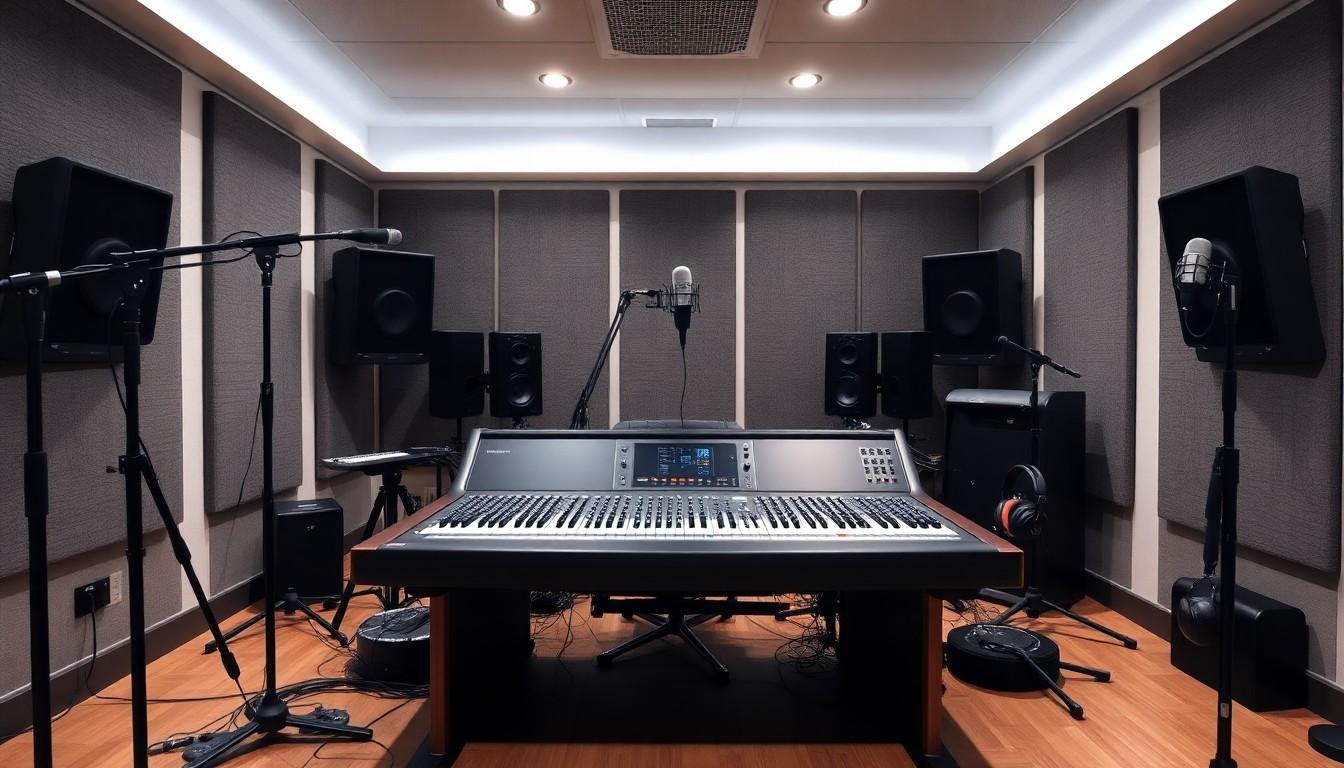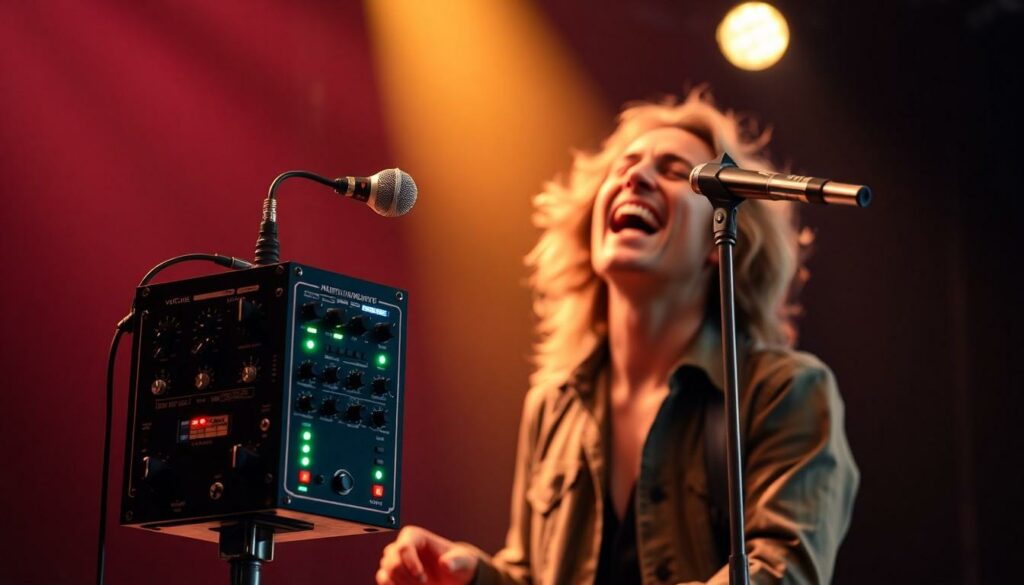Ever wondered how modern musicians achieve those otherworldly vocal effects that make their songs so captivating? Enter the vocal processor – a magical box that transforms ordinary voices into extraordinary sonic experiences. From subtle pitch correction to mind-bending harmonies this powerful device has revolutionized music production.
Musicians and producers worldwide rely on vocal processors to create everything from radio-ready pop hits to experimental soundscapes. These versatile tools can add depth harmonies and character to any vocal performance while fixing minor pitch imperfections in real-time. It’s like having a complete recording studio engineer packed into a compact device that fits in your hand.
Vocal Processor
A vocal processor operates as a digital signal processing device dedicated to modifying vocal input signals. It manipulates incoming audio through a combination of digital algorithms configured in specific signal chains.
The core functionality involves three primary stages:
-
- Input Stage
-
- Converts analog vocal signals to digital data
-
- Analyzes pitch frequency content
-
- Detects amplitude variations
-
- Processing Stage
-
- Applies selected effects (reverb, delay, compression)
-
- Executes pitch correction algorithms
-
- Creates harmonies from the original signal
-
- Modulates voice characteristics (formant shifting)
-
- Output Stage
-
- Converts processed digital signals back to analog
-
- Balances wet/dry signal mix
-
- Routes audio to amplification systems
Common vocal processor features include:
-
- Auto-Tune: Corrects pitch inaccuracies in real-time
-
- Harmonizer: Generates additional vocal harmonies
-
- Effects Processing: Adds reverb chorus delay
-
- Dynamics Control: Manages volume levels
-
- De-essing: Reduces harsh sibilant sounds
| Processing Type | Latency Range | Common Applications |
|---|---|---|
| Pitch Correction | 2-10ms | Live Performance |
| Harmony Generation | 10-20ms | Studio Recording |
| Effects Processing | 1-5ms | Both Live/Studio |
The signal flow moves through specialized integrated circuits transforming the original voice into enhanced output. Modern processors integrate USB connectivity enabling direct computer integration for expanded control options.
Types of Vocal Processing Effects

Vocal processors offer diverse effects that shape vocal performances in multiple ways. Each effect category serves specific functions in modern music production.
Pitch Correction and Auto-Tune
Pitch correction technology transforms off-key vocals into perfectly tuned notes. Auto-Tune applies real-time pitch adjustments by analyzing incoming audio signals and shifting them to the nearest correct semitone. Modern processors feature variable correction speeds, from subtle natural-sounding adjustments to dramatic robotic effects popularized in contemporary pop music. Advanced algorithms detect vibrato patterns and preserve them while correcting pitch imperfections. Many units include chromatic scale options plus custom scale programming for specific musical modes.
Harmonization and Doubling
Harmonization effects create additional vocal parts from a single voice input. Digital processors generate up to 4 harmony voices above or below the original note, following preset musical intervals or custom chord progressions. Intelligent harmonizers analyze the input melody to produce musically appropriate harmonies in the correct key. Doubling effects simulate multiple takes of the same vocal line by adding slight variations in timing and pitch, creating thickness and depth in the vocal arrangement.
Reverb and Delay
Reverb processors simulate acoustic spaces by generating complex reflection patterns. Digital algorithms recreate environments from small rooms to large concert halls with adjustable parameters for decay time, early reflections and room size. Delay effects produce distinct vocal echoes with controllable feedback and timing divisions synced to tempo. Popular delay styles include slapback for rockabilly sounds, ping-pong for stereo movement plus modulated delays that add chorusing effects. Modern units combine multiple delay lines with filtered feedback paths for creative sound design.
Popular Vocal Processor Models
Modern vocal processors come in diverse hardware configurations software solutions, each offering unique features for different production needs.
Hardware Processors
Top-selling hardware vocal processors include the TC Helicon VoiceLive 3 Extreme, Boss VE-500, and Roland VT-4. The TC Helicon VoiceLive 3 Extreme integrates multiple effects processors with advanced pitch correction features in a floor-based unit format. Roland’s VT-4 delivers real-time vocal transformation with intuitive controls for pitch shifting harmonization effects. The Boss VE-500 combines professional studio-quality processing with 90 customizable memory locations for storing effect combinations.
Notable mentions include:
-
- BOSS VE-20: Compact pedal design with essential vocal effects
-
- DigiTech VLFX: Multi-effects processor with gender modification
-
- Electro-Harmonix Voice Box: Specialized harmonizer with polyphonic effects
-
- TC Helicon Play Electric: Guitar-focused vocal processor with adaptive tone
Software Solutions
Professional vocal processing software platforms deliver studio-grade processing capabilities through digital audio workstations. Antares Auto-Tune Pro represents the industry standard for pitch correction with advanced graph mode editing. Melodyne offers precise pitch manipulation with DNA technology for polyphonic processing. Waves Tune Real-Time provides instantaneous pitch correction for live recording sessions.
-
- iZotope Nectar: Complete vocal production suite
-
- Soundtoys Little AlterBoy: Creative pitch shifting effects
-
- Celemony Melodyne Studio: Advanced audio manipulation tools
-
- Waves Vocal Rider: Automated volume control processing
-
- VocalSynth 2: Innovative vocal synthesis platform
Key Features to Consider When Buying
Selecting an optimal vocal processor requires evaluating specific technical aspects that impact performance quality. The following features determine the effectiveness of a vocal processor in both studio recording sessions and live performances.
Sound Quality and Latency
High-quality vocal processors deliver 24-bit/96kHz audio resolution with a signal-to-noise ratio exceeding 100dB. Top-tier processors maintain pristine audio fidelity through studio-grade preamps incorporating premium A/D converters. The processing speed affects real-time performance, with professional units achieving latency below 3ms. Modern processors use dedicated DSP chips to handle complex effects without introducing audio artifacts or delays. Premium models feature dual-core processors that separate effect routing from pitch detection, enabling simultaneous processing of multiple effects.
Connectivity Options
Modern vocal processors offer diverse connection options for integration with various audio systems. XLR inputs support professional microphones with phantom power while 1/4-inch jacks accommodate instrument-level signals. USB connectivity enables direct computer integration for firmware updates and preset management. MIDI ports allow synchronization with external devices such as keyboards or drum machines. Digital outputs (S/PDIF or ADAT) provide direct connection to audio interfaces, while dedicated footswitch inputs enable hands-free control during performances.
User Interface
Intuitive control layouts feature LCD screens displaying real-time parameters with dedicated knobs for quick adjustments. Touch-sensitive interfaces provide immediate access to effect parameters through gesture controls. Programmable footswitches store up to 500 custom presets for instant recall during performances. Color-coded LED indicators display active effects status at a glance. Menu navigation systems utilize category-based organization for efficient preset management. Quick-access buttons enable instant engagement of commonly used effects like harmonies or pitch correction.
Best Ways to Use a Vocal Processor
Vocal processors transform live performances and studio recordings through strategic application of effects and processing techniques. The following approaches maximize the potential of these versatile devices in different contexts.
Live Performance Applications
Live vocal processing requires precise control over effect parameters and quick preset changes. Setting up 3-4 go-to presets enables smooth transitions between song sections. Performers integrate harmonizer effects during chorus sections while maintaining cleaner processing for verses. Mapping footswitches to specific parameters like reverb depth or delay feedback allows real-time adjustments without interrupting the performance. Strategic placement of compression maintains consistent vocal levels across dynamic ranges. Using shorter reverb times (0.8-1.2 seconds) prevents muddiness in live sound systems. Engaging pitch correction subtly at 50-70% strength provides natural-sounding tuning support without obvious artifacts.
Studio Recording Tips
Recording engineers capture clean vocal signals before applying processor effects to maintain editing flexibility. Tracking with minimal effects allows proper gain staging and prevents processing artifacts. Setting pitch correction response times between 15-25ms creates transparent tuning adjustments. Engineers place vocal processors on aux sends to blend processed and dry signals in parallel. Recording multiple takes with different harmonizer settings generates layered vocal arrangements. Automating effect parameters throughout the song adds movement and interest to the vocal production. Creating custom presets for different vocal styles streamlines the recording workflow. Engineers monitor latency levels below 10ms to ensure precise vocal timing during overdubs.
Common Mistakes to Avoid
Incorrect gain staging creates unwanted distortion when setting input levels too high or generates excess noise with levels too low.
Setting excessive pitch correction leads to artificial robotic effects, limiting natural vocal expression in performances.
Adding too many effects simultaneously muddles the vocal signal, making it difficult to sit properly in the mix.
Bypassing proper signal routing causes feedback loops or signal degradation in live performance setups.
Forgetting to save presets results in lost settings, forcing performers to recreate effect combinations during critical moments.
Processing vocals without proper monitoring creates misleading results since room acoustics affect perception of effects.
Using identical vocal processing across different song sections reduces dynamic contrast, making performances sound monotonous.
Applying heavy compression before other effects chain elements limits the effectiveness of subsequent processing stages.
Common technical errors include:
-
- Connecting unbalanced cables to balanced inputs
-
- Neglecting proper grounding connections
-
- Running processor outputs directly into guitar amplifiers
-
- Using inappropriate sample rates for digital connections
Performance-related mistakes involve:
-
- Relying too heavily on harmonizer effects
-
- Not adjusting effect parameters between songs
-
- Failing to match reverb settings to venue acoustics
-
- Moving too far from microphones when effects are active
-
- Recording with effects instead of tracking dry signals
-
- Using presets without customizing parameters
-
- Overprocessing background vocals
-
- Neglecting to back up custom settings
How Does It Work
Vocal processors have revolutionized modern music production by offering powerful tools for both live performances and studio recordings. From pitch correction and harmonization to creative effects these devices serve as essential components in shaping contemporary vocal sounds.
Whether choosing hardware units like the TC Helicon VoiceLive 3 Extreme or software solutions such as Auto-Tune Pro success with vocal processors depends on understanding their features and applying them appropriately. With proper setup knowledge of common pitfalls and regular practice musicians and producers can harness these versatile tools to create professional-quality vocal productions.
The future of vocal processing continues to evolve with advancing technology making these tools more accessible and powerful than ever before.

